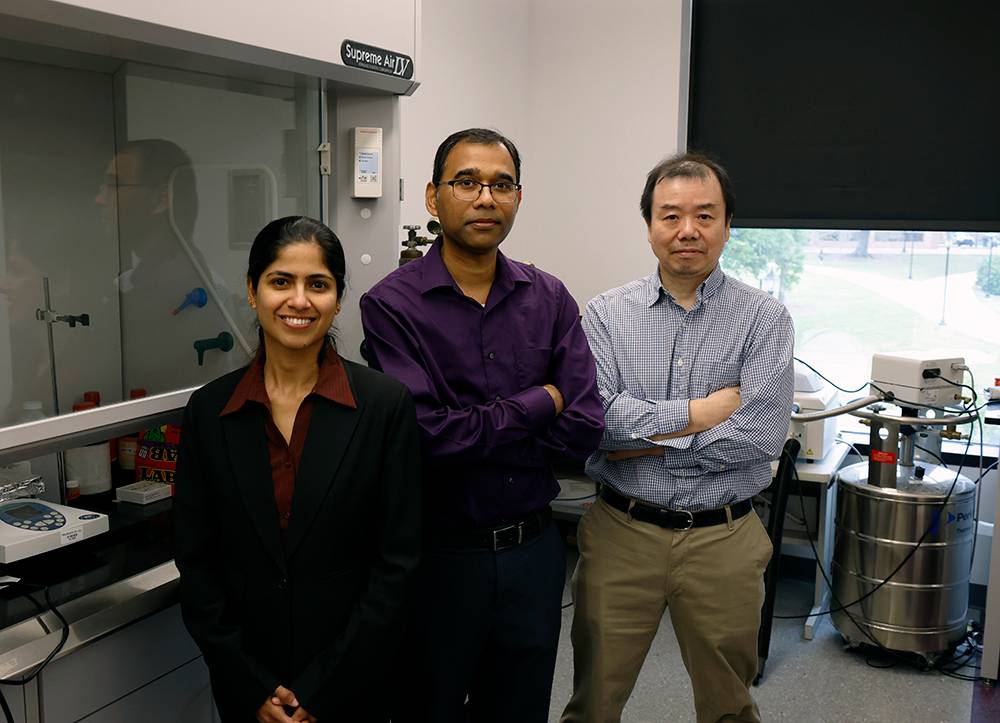LSU PETE Professor, Research Team Aim To Prevent Nuclear Power Leaks
March 20, 2023
 BATON ROUGE, LA – Though nuclear energy provides more than 20% of the electricity
in the United States, it is still considered by many to be a controversial source
of power due to famous leakage disasters such as Chernobyl, Three Mile Island, and
Fukushima. But what if those disasters could have been avoided by having a sensor
that immediately detected a leak?
BATON ROUGE, LA – Though nuclear energy provides more than 20% of the electricity
in the United States, it is still considered by many to be a controversial source
of power due to famous leakage disasters such as Chernobyl, Three Mile Island, and
Fukushima. But what if those disasters could have been avoided by having a sensor
that immediately detected a leak?
That is exactly what LSU Engineering researchers are working on thanks to a $500,000 grant from the Nuclear Regulatory Commission, the first NRC research grant LSU has ever received.
LSU Craft & Hawkins Department of Petroleum Engineering Assistant Professor Jyotsna Sharma is leading a team of researchers that includes LSU Mechanical and Industrial Engineering Associate Professor Manas Gartia, LSU Geology & Geophysics Associate Professor Jianwei Wang, Southern University Professors Ali Fazely and Terrance Reece, and LSU Engineering and Southern University students to develop and demonstrate a novel, multifunctional distributed fiber-optic sensor (DFOS) that will immediately detect a radiation leak.
“Nuclear power plants require constant monitoring to ensure operational efficiency and safety,” Sharma said. “This includes the monitoring of plant structures and components for abnormal stresses and leaks due to aging and degradation, safe storage of nuclear waste, and reliable long-term radiation monitoring. A DFOS can overcome many limitations of traditional gauges since they are immune to electromagnetic interference, chemically inert, resistant to corrosion, and can withstand high temperatures, high pressures, and neutron and gamma radiations.”
The entire fiber-optic cable acts as a sensor, providing spatially and temporally continuous monitoring along the fiber with no additional electronics along the optical path. A 100-ft. fiber, for instance, will have a 100-ft. sensor. If there is a leak, especially a radiation leak, Sharma’s team wants to quickly find the leak using a DFOS, which allows real-time measurement along the fiber.
“A gamma or neutron leak is one of the biggest safety hazards in a nuclear plant,” Sharma said. “We should be able to detect it right away. With a DFOS, light is carrying the data, and light travels at a very fast speed. So, we are transmitting the data very quickly. What will be different in a nuclear setting, especially if we are trying to detect radiation, is that we need to have the nanomaterials sensitive to certain types of radiation, such as gamma and neutron.”
Using Gartia’s lab in Patrick F. Taylor Hall, nanomaterials will be tested for gamma ray and neutron detection for a radioactive environment in a nuclear reactor. Once the nanomaterial is identified, Sharma will put it on the fiber-optic sensor, as she is familiar with them from working in the oil and gas industry for many years, as well as having a degree in electrical engineering.
Sharma’s team hopes its research will eventually help keep all nuclear power plants safe, including the two in Louisiana that produce 16% of the state’s energy. The 974-megawatt River Bend facility in St. Francisville recently received a license renewal through 2045, while the 1,159-megawatt Waterford 3 unit in Killona received a license renewal through 2044. Both plants, owned by Entergy, employ more than 1,500 employees.
“Nuclear power is crucial to the U.S. Gulf Coast region, with two nuclear power plants in Louisiana and another eight in neighboring Mississippi, Arkansas, and Alabama,” Sharma said. “Therefore, strengthening the nuclear research capabilities, educational infrastructure, and nuclear workforce in Louisiana will be a strong focus of the proposed disciplinary partnership.”
Like us on Facebook (@lsuengineering) or follow us on Twitter and Instagram (@lsuengineering).
###
Contact: Libby Haydel
Communications Manager
225-578-4840
ehaydel1@lsu.edu